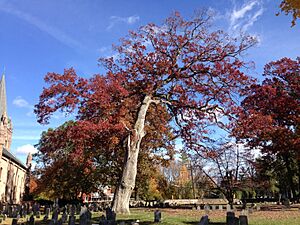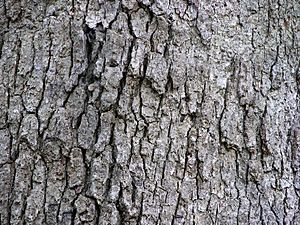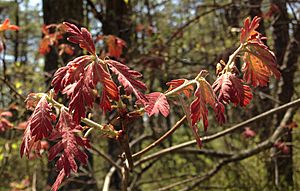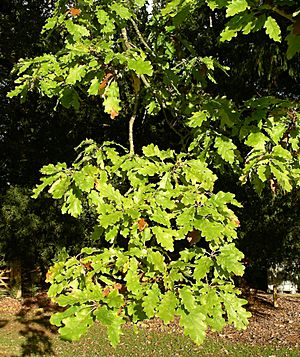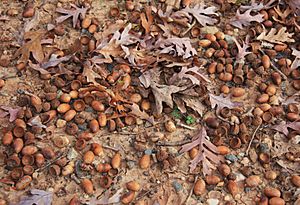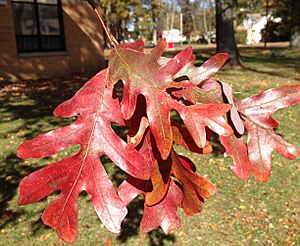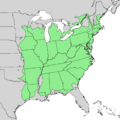Quercus alba facts for kids
Quick facts for kids White oak |
|
|---|---|
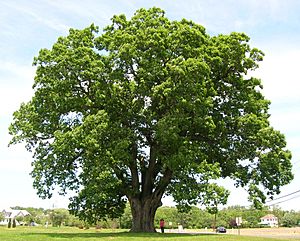 |
|
| A large white oak in New Jersey | |
| Conservation status | |
| Scientific classification | |
| Genus: |
Quercus
|
| Species: |
alba
|
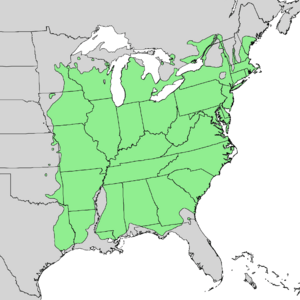 |
|
| Natural range | |
| Synonyms | |
|
List
Quercus candida Steud.
Quercus nigrescens Raf. Quercus ramosa Dippel Quercus repanda Michx. Quercus retusa Raf. |
|
The white oak (scientific name: Quercus alba) is a very important hardwood tree. It grows across eastern and central North America. This long-lived oak tree is found from Minnesota all the way down to northern Florida. It also grows from Ontario to eastern Texas. Some white oak trees have lived for over 450 years!
Even though it's called a white oak, its bark is usually light gray. The name "white oak" actually comes from the color of its wood once it's cut and finished. In a forest, these trees can grow very tall. In open areas, they become wide with large branches spreading out.
Contents
Discover the White Oak Tree
White oaks usually grow to be about 24 to 30 meters (80 to 100 feet) tall. Their branches can spread out very wide, sometimes parallel to the ground. Trees in forests grow taller and straighter. Trees in open areas tend to be shorter and wider. The Mingo Oak was once the tallest known white oak. It was about 44 meters (145 feet) tall before it was cut down in 1938. Some white oaks can be as wide as they are tall. However, at high altitudes, they might only grow as small shrubs.
White oak trees can live for 200 to 300 years. Some have lived even longer. The Wye Oak in Maryland was over 450 years old. It fell during a thunderstorm in 2002. Another famous tree was the Great White Oak in New Jersey. It was thought to be over 600 years old when it died in 2016. This tree was huge. Its base was about 7.6 meters (25 feet) around. Its branches spread over 38 meters (125 feet). This ancient tree was taken down in 2017.
White Oak Bark and Leaves
The bark of the white oak is a light ash-gray color. It often peels a little from the top or sides.
In spring, the young leaves are a delicate silvery pink. They are covered with soft, fuzzy hairs. These new leaves make the whole tree look misty and frosty. Over several days, they change from soft pink to silvery white, then to yellow-green.
Mature leaves are about 13 to 22 centimeters (5 to 8.5 inches) long. They are 7 to 11 centimeters (2.75 to 4.5 inches) wide. The top side is a deep, shiny green. In autumn, they usually turn red or brown. Some trees can be nearly always red or even purple in fall. Sometimes, dead leaves stay on the tree through winter until early spring. The leaves have rounded lobes. These lobes can be shallow or deep.
Acorns and Reproduction
White oak trees start producing acorns around 20 years old. However, they don't produce many acorns until they are about 50 years old. The number of acorns varies each year. The acorns are usually about 1 to 2.5 centimeters (0.5 to 1 inch) long. They fall in early October.
White oak acorns don't stay dormant for long. They start to sprout quickly after they fall. In most cases, the root grows in the fall. The leaves and stem appear the next spring. Unlike red oak acorns, white oak acorns only take one growing season to develop. Acorns are a favorite food for insects and animals. If there are not many acorns, they might all be eaten. This means no new trees can grow from them.
Similar Trees
The white oak is sometimes confused with the swamp white oak. This is a closely related species. It can also be confused with the bur oak. White oaks can even mix with other oak types. They can hybridize with the bur oak, the post oak, and the chestnut oak.
Where White Oaks Grow
Quercus alba can grow in many different places. You can find it on ridges, in valleys, and in both dry and moist areas. It grows well in moderately acidic or alkaline soils. It is mostly a lowland tree. However, it can grow up to 1,600 meters (5,249 feet) high in the Appalachian Mountains. It is often a key part of the forest in an oak-heath forest.
Long ago, frequent fires in the central United States stopped oak forests from spreading. After European settlers arrived, these fires became less common. This allowed oak forests, including white oaks, to expand quickly. This change, however, negatively affected the natural prairie plants.
How White Oak Trees Are Used
Growing White Oaks
White oaks are not often grown as ornamental trees in gardens. This is because they grow slowly and become very large. They don't do well with city pollution or road salt. Also, their large taproot makes them unsuitable for planting along streets or in small garden areas.
Food Source
White oak acorns are less bitter than red oak acorns. They are also smaller than most other oak acorns. Humans can eat them. If they are bitter, they might need to be soaked to remove bitter substances called tannins. These acorns are also a valuable food for many animals. This includes turkeys, wood ducks, pheasants, squirrels, and deer. White oak is the only known food plant for two types of caterpillars: Bucculatrix luteella and Bucculatrix ochrisuffusa.
Deer often eat the young shoots of many eastern oak species. In fall or winter, white-tailed deer sometimes eat dried oak leaves. Rabbits also chew on twigs and can damage young trees.
Wood Uses
White oak wood has special cells called tyloses. These make the wood very resistant to water and rot. Because of this, coopers (barrel makers) use white oak to make wine and whiskey barrels. The wood prevents the liquids from leaking out. White oak has also been used to build houses, ships, and farm tools.
When white oak wood is quarter sawn, it shows a beautiful pattern. This pattern comes from its prominent medullary rays. Quarter sawn white oak was very popular in Mission style furniture. Gustav Stickley used it a lot in his Craftsman style pieces.
White oak is also used in Japanese martial arts for weapons. These include the bokken (wooden sword) and jo (wooden staff). It is chosen for its strength and toughness. It also splinters less easily than cheaper red oak if it breaks.
The famous ship USS Constitution was built using white oak and southern live oak. This made the ship very strong against cannon fire. When parts of the Constitution need to be replaced, the white oak comes from a special grove. This grove is called the "Constitution Grove." It is located at Naval Surface Warfare Center Crane Division.
Musical Instruments
Deering Banjo Company has made several 5-string banjos using white oak. These include banjos from the Vega series and the White Lotus. White oak gives a softer sound than maple, which is often used. However, it still has enough power without needing a metal tone ring.
Oak Barrels for Drinks
Barrels made from American white oak are often used to age wine. The wood gives the wine strong flavors. Also, by law, bourbon whiskey must be aged in new, charred oak barrels. These are usually American white oak barrels.
White Oak in Culture

The white oak is the official state tree of Illinois. School children voted for it. Illinois has two "official" white oaks. One is at the governor's mansion. The other is in a schoolyard in Rochelle. The white oak is also the state tree of Connecticut and Maryland. The Wye Oak was Maryland's honorary state tree. It was probably the oldest living white oak until it fell in 2002.
The Charter Oak in Hartford, Connecticut, is one of America's most famous white oaks. It is part of a legend as old as the colony itself. An image of this tree is now on the back of the Connecticut state quarter.
The "Shawshank tree" from the movie The Shawshank Redemption was a white oak. It was estimated to be over 200 years old when it fell. This tree became very popular after the movie. It attracted many fans and tourists. Part of the tree fell in 2011 during a lightning storm. The rest of the tree fell in 2016 during heavy winds.
The Bedford Oak is a 500-year-old white oak tree. It is located in the town of Bedford, New York. It is the town's mascot. The land where the tree stands was given to the town in 1942. This tree has seen a lot of history. It was there during Native American settlements, the Revolutionary War, and modern times.
Images for kids
See also
 In Spanish: Roble blanco americano para niños
In Spanish: Roble blanco americano para niños



